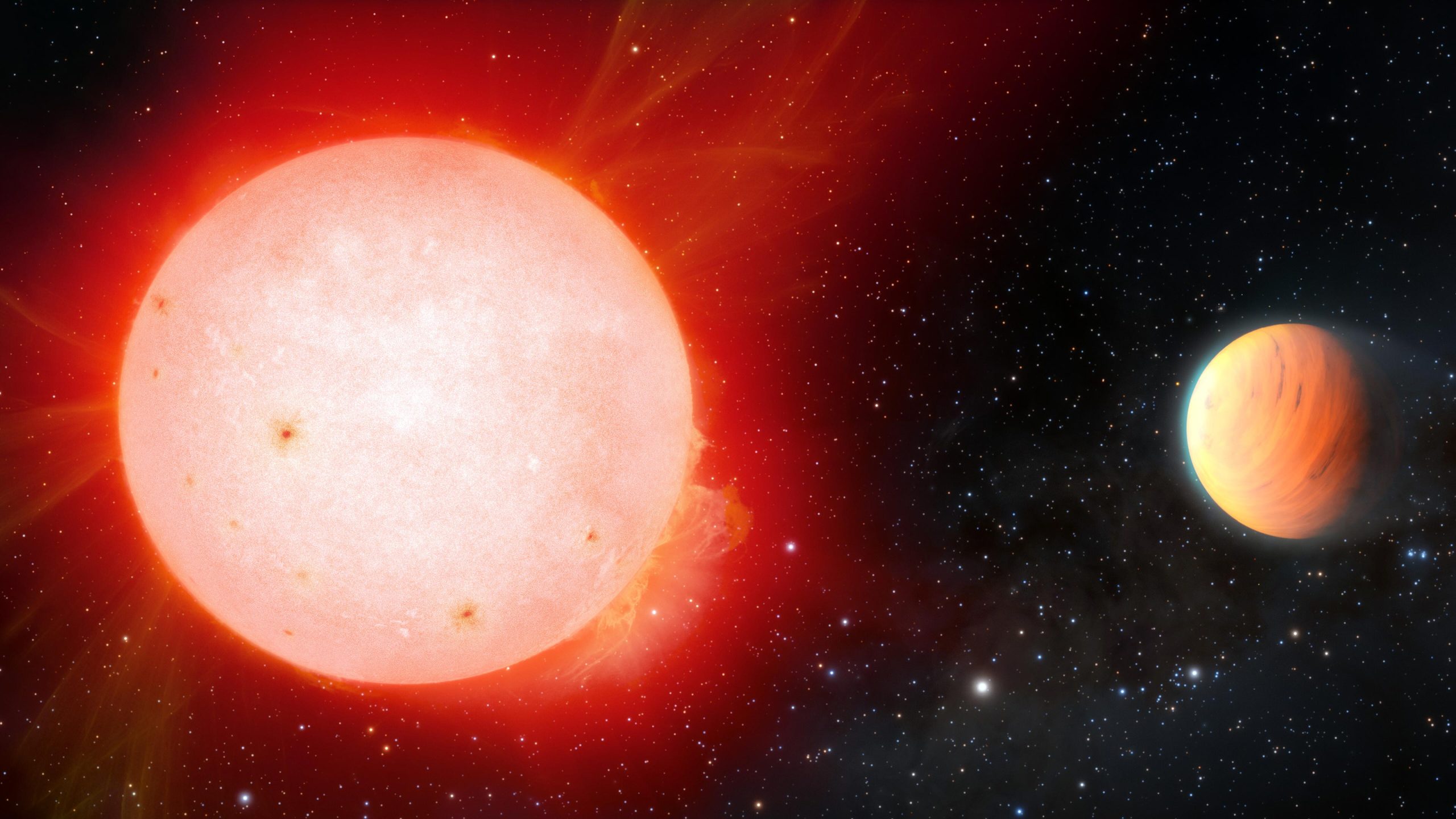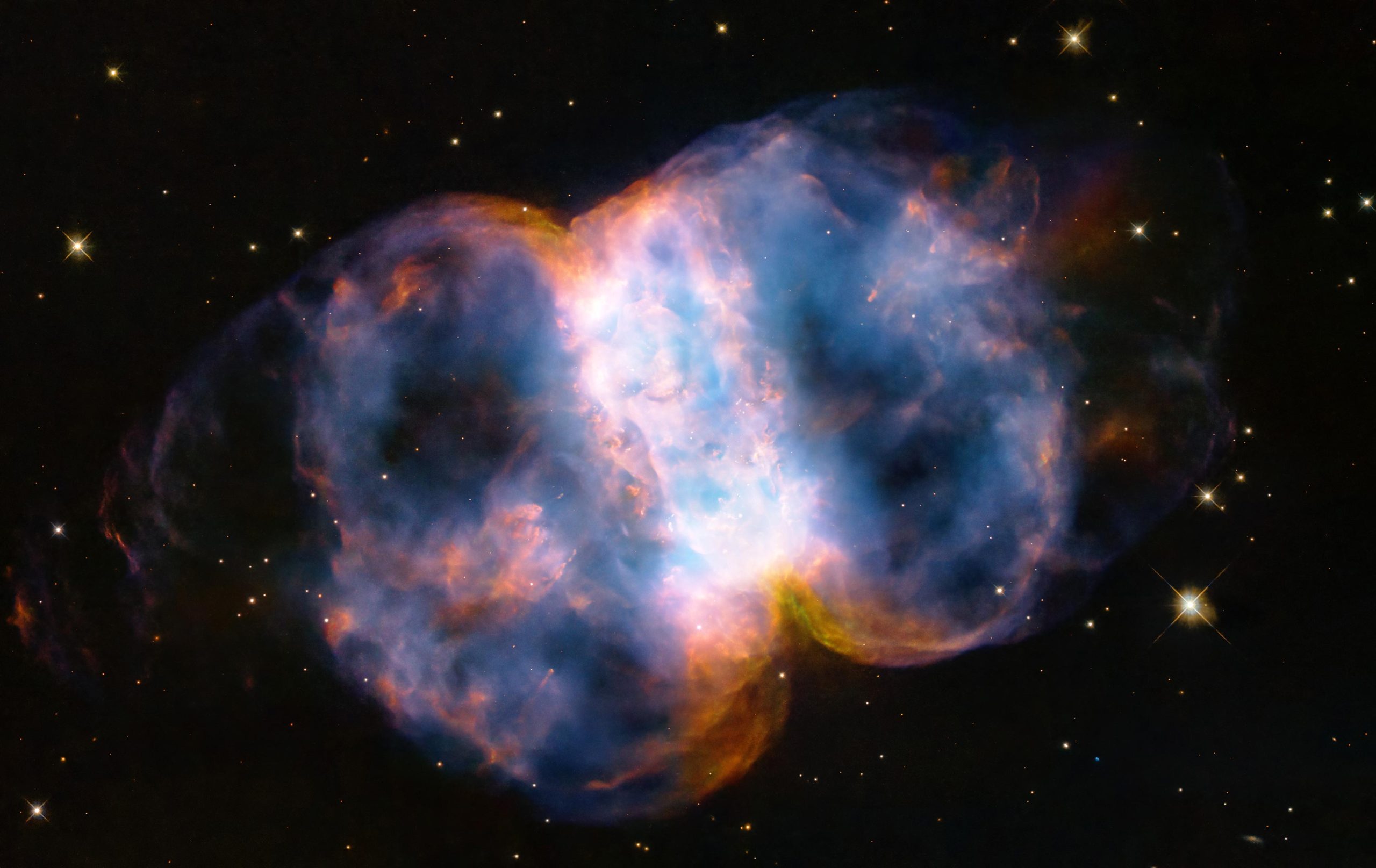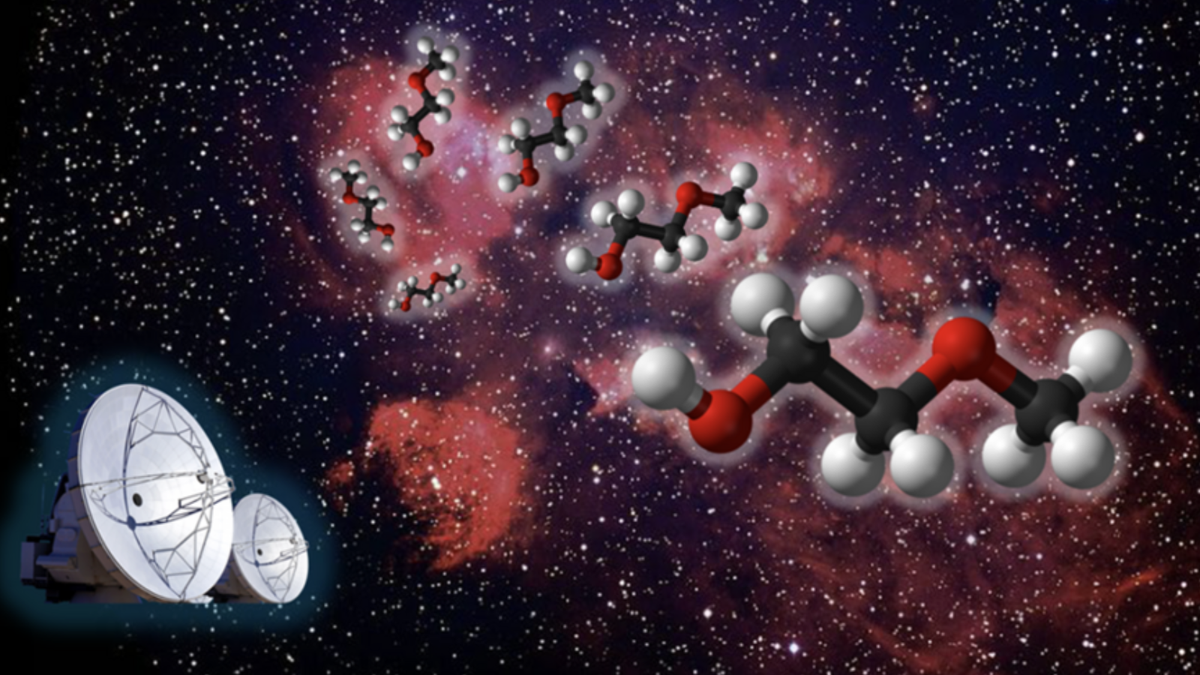انطباع فنان عن كوكب عملاق غازي رقيق للغاية يدور حول نجم قزم أحمر. كوكب خارجي عملاق غازي [right] تم الكشف عن كثافات الخطمي في مدار حول نجم قزم أحمر بارد. [left] مشروع NOIRLab التابع لمؤسسة NSF مع أداة السرعة الشعاعية NEID الممولة من وكالة ناسا في تلسكوب WIYN بطول 3.5 متر في مرصد Kitt Peak الوطني. الكوكب ، المسمى TOI-3757 b ، هو أول كوكب غازي عملاق رقيق تم اكتشافه حول هذا النوع من النجوم. الائتمان: NOIRLab / NSF / AURA / J. دا سيلفا / محرك الفضاء / م. جماني
يساعد المرصد الوطني لقمة الأطفال في تحديد ذلك[{” attribute=””>Jupiter-like Planet is the lowest-density gas giant ever detected around a red dwarf.
A gas giant exoplanet with the density of a marshmallow has been detected in orbit around a cool red dwarf star. A suite of astronomical instruments was used to make the observations, including the NASA-funded NEID radial-velocity instrument on the WIYN 3.5-meter Telescope at Kitt Peak National Observatory, a Program of NSF’s NOIRLab. Named TOI-3757 b, the exoplanet is the fluffiest gas giant planet ever discovered around this type of star.
Using the WIYN 3.5-meter Telescope at Kitt Peak National Observatory in Arizona, astronomers have observed an unusual Jupiter-like planet in orbit around a cool red dwarf star. Located in the constellation of Auriga the Charioteer around 580 light-years from Earth, this planet, identified as TOI-3757 b, is the lowest-density planet ever detected around a red dwarf star and is estimated to have an average density akin to that of a marshmallow.
Red dwarf stars are the smallest and dimmest members of so-called main-sequence stars — stars that convert hydrogen into helium in their cores at a steady rate. Although they are “cool” compared to stars like our Sun, red dwarf stars can be extremely active and erupt with powerful flares. This can strip orbiting planets of their atmospheres, making this star system a seemingly inhospitable location to form such a gossamer planet.
https://www.youtube.com/watch؟v=hRgGzfgH4gA
يقول شوبهام كانوديا ، الباحث في معهد كارنيجي لمختبر الأرض والكواكب والمؤلف الأول للورقة البحثية: “كان يُعتقد تقليديًا أن الكواكب العملاقة حول النجوم القزمة الحمراء يصعب تكوينها”. الفلكية جورنال. “حتى الآن ، شوهد هذا فقط في عينات صغيرة من استطلاعات دوبلر ، والتي عادة ما تجد كواكب عملاقة بعيدة عن هذه النجوم القزمة الحمراء. ليس لدينا ما يكفي من الكواكب حتى الآن للعثور بشكل نهائي على أقرب الكواكب الغازية.
لا تزال هناك ألغاز غير مفسرة تحيط بـ TOI-3757 b ، وأكبرها كيف يتشكل كوكب غازي عملاق حول نجم قزم أحمر ، خاصةً كوكب منخفض الكثافة. ومع ذلك ، يعتقد فريق Kanodia أنه قد يكون لديهم حل للغز.

من أراضي مرصد كيت بيك الوطني (KPNO) ، وهو مشروع تابع لمؤسسة NSF NOIRLab ، يراقب تلسكوب ويسكونسن-إنديانا-ييل-NOIRLab (WIYN) الذي يبلغ ارتفاعه 3.5 متر مجرة درب التبانة وهي تسقط من الأفق. الهالة الحمراء ، وهي ظاهرة طبيعية ، تلون الأفق أيضًا. يقع KPNO في صحراء أريزونا سونوران في Tohono O’Tham Nation وهذه الرؤية الواضحة لجزء من طائرة مجرة درب التبانة تُظهر الظروف المواتية اللازمة لرؤية الأجرام السماوية الباهتة في هذه البيئة. سمحت هذه الظروف ، بما في ذلك المستويات المنخفضة من التلوث الضوئي ، والسماء المظلمة التي تزيد عن 20 درجة والظروف الجوية الجافة ، لباحثي اتحاد WIYN بمراقبة المجرات والسدم والكواكب الخارجية ، بالإضافة إلى العديد من الأهداف الفلكية الأخرى. تلسكوب WIYN 3.5 متر والتلسكوب الشقيق له WIYN 0.9 متر. الائتمان: KPNO / NOIRLab / NSF / AURA / R. شرارات
يقترحون أن الكثافة المنخفضة للغاية لـ TOI-3757 b قد تكون نتيجة عاملين. الأول يتعلق بالنواة الصخرية للكوكب ؛ يُعتقد أن عمالقة الغاز تبدأ على شكل نوى صخرية ضخمة تبلغ كتلتها حوالي عشرة أضعاف كتلة الأرض ، وعند هذه النقطة تسحب بسرعة كميات كبيرة من الغاز المجاور لتشكيل عمالقة الغاز التي نراها اليوم. يحتوي نجم TOI-3757b على عدد أقل من العناصر الثقيلة مقارنة بعمالقة الغاز M-dwarf الأخرى ، ونتيجة لذلك يتشكل اللب الصخري ببطء ، مما يؤخر ظهور تراكم الغاز ويؤثر على الكثافة الإجمالية للكوكب.
قد يكون العامل الثاني هو مدار الكوكب ، والذي يُعتقد مبدئيًا أنه بيضاوي الشكل قليلاً. هناك أوقات يكون فيها أقرب إلى نجمه من الأوقات الأخرى ، مما ينتج عنه حرارة زائدة كبيرة يمكن أن تنتفخ الغلاف الجوي للكوكب.
قمر ناسا العابر لاستطلاع الكواكب الخارجية ([{” attribute=””>TESS) initially spotted the planet. Kanodia’s team then made follow-up observations using ground-based instruments, including NEID and NESSI (NN-EXPLORE Exoplanet Stellar Speckle Imager), both housed at the WIYN 3.5-meter Telescope; the Habitable-zone Planet Finder (HPF) on the Hobby-Eberly Telescope; and the Red Buttes Observatory (RBO) in Wyoming.
TESS surveyed the crossing of this planet TOI-3757 b in front of its star, which allowed astronomers to calculate the planet’s diameter to be about 150,000 kilometers (100,000 miles) or about just slightly larger than that of Jupiter. The planet finishes one complete orbit around its host star in just 3.5 days, 25 times less than the closest planet in our Solar System — Mercury — which takes about 88 days to do so.
The astronomers then used NEID and HPF to measure the star’s apparent motion along the line of sight, also known as its radial velocity. These measurements provided the planet’s mass, which was calculated to be about one-quarter that of Jupiter, or about 85 times the mass of the Earth. Knowing the size and the mass allowed Kanodia’s team to calculate TOI-3757 b’s average density as being 0.27 grams per cubic centimeter (about 17 grams per cubic feet), which would make it less than half the density of Saturn (the lowest-density planet in the Solar System), about one quarter the density of water (meaning it would float if placed in a giant bathtub filled with water), or in fact, similar in density to a marshmallow.
“Potential future observations of the atmosphere of this planet using NASA’s new James Webb Space Telescope could help shed light on its puffy nature,” says Jessica Libby-Roberts, a postdoctoral researcher at Pennsylvania State University and the second author on this paper.
“Finding more such systems with giant planets — which were once theorized to be extremely rare around red dwarfs — is part of our goal to understand how planets form,” says Kanodia.
The discovery highlights the importance of NEID in its ability to confirm some of the candidate exoplanets currently being discovered by NASA’s TESS mission, providing important targets for the new James Webb Space Telescope (JWST) to follow up on and begin characterizing their atmospheres. This will in turn inform astronomers what the planets are made of and how they formed and, for potentially habitable rocky worlds, whether they might be able to support life.
Reference: “TOI-3757 b: A low-density gas giant orbiting a solar-metallicity M dwarf” by Shubham Kanodia, Jessica Libby-Roberts, Caleb I. Cañas, Joe P. Ninan, Suvrath Mahadevan, Gudmundur Stefansson, Andrea S. J. Lin, Sinclaire Jones, Andrew Monson, Brock A. Parker, Henry A. Kobulnicky, Tera N. Swaby, Luke Powers, Corey Beard, Chad F. Bender, Cullen H. Blake, William D. Cochran, Jiayin Dong, Scott A. Diddams, Connor Fredrick, Arvind F. Gupta, Samuel Halverson, Fred Hearty, Sarah E. Logsdon, Andrew J. Metcalf, Michael W. McElwain, Caroline Morley, Jayadev Rajagopal, Lawrence W. Ramsey, Paul Robertson, Arpita Roy, Christian Schwab, Ryan C. Terrien, John Wisniewski and Jason T. Wright, 5 August 2022, The Astronomical Journal.
DOI: 10.3847/1538-3881/ac7c20








